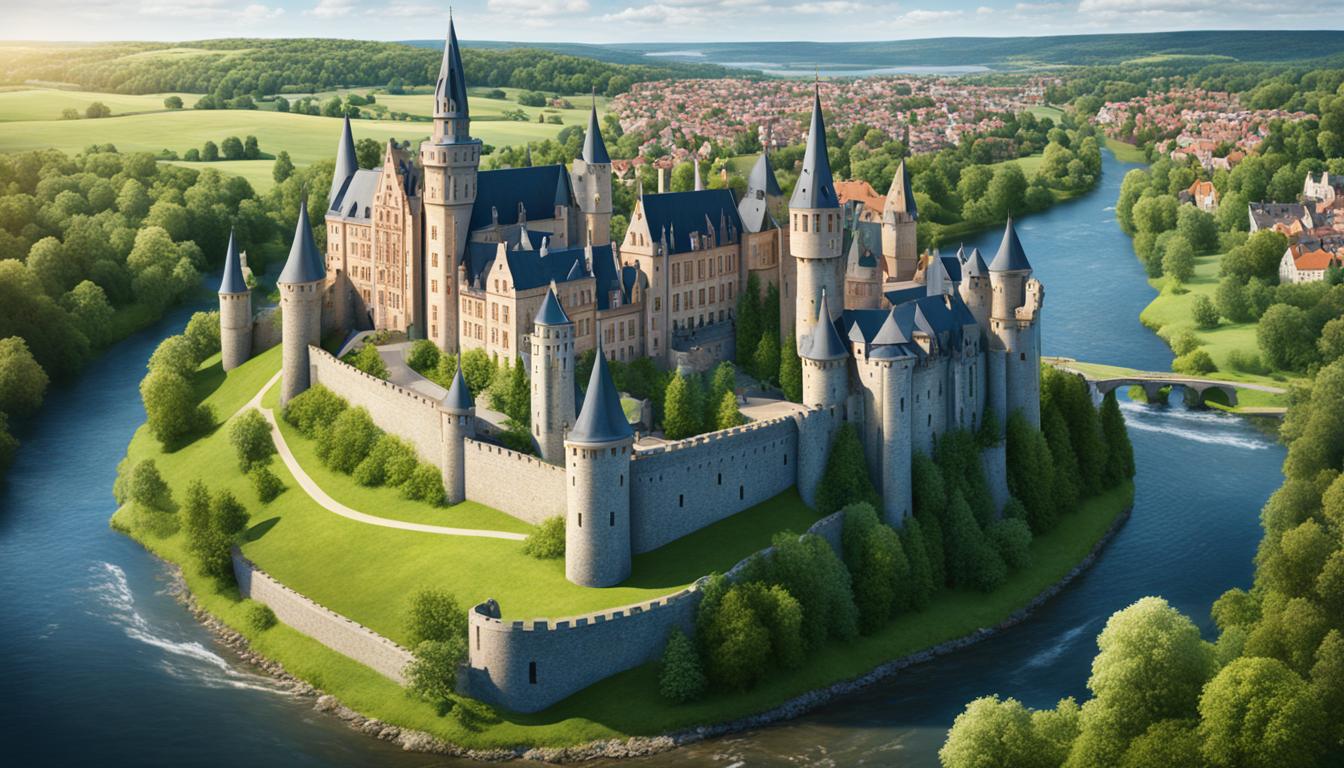Step Back in Time: Explore These Historical Landmarks in Denmark!
Ever wonder what life was like during the Viking times? Or how Denmark, a small country, has shaped European history? Denmark is full of historical landmarks that tell stories of the past. These sites are not just old buildings; they are stories waiting for you to discover.
See the big Kronborg Castle, where Shakespeare’s Hamlet took place. Or visit the Jelling Stones, a UNESCO site. Denmark has over 444 islands and a long history. Visitors can learn about kings, queens, and Vikings, and understand Danish culture.
Key Takeaways
- Denmark features some of the world’s oldest historical landmarks, each with unique stories.
- The stunning architecture of castles like Frederiksborg reflects its royal history.
- UNESCO sites, such as the Jelling Stones, reveal Denmark’s Viking past.
- Rich cultural heritage is embedded in towns like Ribe and Odense.
- Denmark’s geographical beauty enhances its historical narratives, with proximity to water everywhere.
- Several ancient sites serve as gateways for visitors to explore Danish cultural influence.
Introduction to Denmark’s Rich History
Denmark’s history goes way back, shaping its culture and identity. The first people came about 10,000 BC as the ice melted. They were hunters and fishermen, setting the stage for others.
By 3000 BC, farming started on the good land. This change from moving around to staying in one place was big. It brought better tools like bronze and iron, making life easier.
The Viking Age began around 793 AD. It was a time of exploring, raiding, and sharing cultures. King Harald Bluetooth’s baptism in 965 AD was a big step, bringing Christianity to Denmark.
In 1397, Denmark, Norway, and Sweden joined together under one king. This was a key moment for Denmark in Europe. Over time, Denmark changed a lot, becoming a constitutional monarchy in 1849. It shows Denmark’s strong spirit through ups and downs.
Today, Denmark’s history is seen in its landmarks. Visiting these places lets us see how people lived and succeeded. Learning about Denmark’s history makes visiting its cultural sites more meaningful.
Kronborg Castle: The Legendary Elsinore Castle

Kronborg Castle is also known as Elsinore Castle. It’s at the northeastern tip of Zealand island. It’s a UNESCO World Heritage site, drawing many visitors every year.
It was built in the 1420s and changed into a Renaissance castle in the late 1500s. This makes it a key part of Danish history. The castle’s beauty and stories tell us about Denmark’s royal past.
Historic Significance of Kronborg
King Eric VII started building the castle in the 1420s. King Frederick II made big changes between 1574 and 1585. He wanted it to be a grand castle.
This castle was more than a royal home. It was important for trade, making money from ships passing by. But, it faced hard times, like a siege by Sweden in 1658. This led to the loss of valuable art.
Later, it was used as a barracks and prison. This shows how its role changed over time.
Visitor Information and Highlights
Visiting Kronborg is a chance to see its stunning architecture and rich history. You can see the Great Hall, royal rooms, and a big moat. The castle is open from 11 AM to 4 PM, offering guided tours.
There are tours for different interests. This makes it fun for families and history lovers. The castle has things to make visiting easy for everyone.
Frederiksborg Castle: The Versailles of the North

Frederiksborg Castle is a key example of Danish Renaissance architecture. It’s called the “Versailles of the North.” Located near Copenhagen, it shows off the grand style of its era. King Christian IV built it in the early 1600s, making it Scandinavia’s biggest Renaissance palace.
Architectural Wonders of Frederiksborg Castle
The castle’s Baroque design and beautiful gardens are a sight to see. The gardens, from the 1700s, have four terraces on a hill. They offer lovely views over a lake.
The castle is also important in history. Its chapel was where Danish rulers were crowned. Inside, you’ll find rooms filled with gilded details, showing the luxury of the past.
Museum of National History
Since 1878, the Museum of National History has been in Frederiksborg Castle. It has a big collection of Danish art and artifacts. The museum covers 500 years, from the Viking Age to today.
Visitors can see things like decorations and sculptures from before a big fire in 1859. This fire damaged the castle a lot.
Many people visit Frederiksborg Castle every year. They enjoy sword fighting lessons and photography exhibits. It’s easy to get to, just 40 minutes from Copenhagen, and costs about 75 DKK (around $12 USD).
The Jelling Stones: A UNESCO World Heritage Site

The Jelling Stones are important symbols of Denmark’s Viking past. They show how the country became Christian. King Harald Bluetooth made them around 965. They mark his rule and Denmark’s change during the Viking Age.
This site is a key part of Denmark’s history. It shows the country’s rich past.
Symbolism and Historical Context
The big runestone has a Nordic dragon on it. It tells of King Harald’s victories in Denmark and Norway. It also shows his work in making the Danes Christian.
The Jelling Mounds are flat-topped structures. They were made to honor a big moment in history. Jelling Church sits on Harald’s old longhouse. It shows the area’s ongoing historical story.
Visiting the Jelling Complex
Going to Jelling takes you back in time. You can see displays and get guided tours. The Viking Market in July lets you experience Viking culture.
There are burial mounds and a museum too. They tell of the shift from paganism to Christianity. It’s important to see how these stones are protected. They can easily get damaged.
A visit here connects you with history. It also shows why we must protect our cultural treasures.
Must-See Historic Towns in Denmark

Denmark’s historic towns are full of culture and history. They let us see the past in a special way. You can explore these towns to learn about Danish culture and history.
From old settlements to cities linked to famous writers, these places are key for understanding Denmark’s history.
Explore the Charm of Ribe
Ribe is Denmark’s oldest town. It has charming streets that take you back in time. The old buildings show its long history.
There are many museums in Ribe. They tell stories of Viking life and the town’s growth over the years. Ribe is a great place for those who love history and culture.
Discover the History of Odense
Odense is famous as the hometown of Hans Christian Andersen. It offers a deep dive into the author’s life. You can see museums and landmarks that tell stories of Andersen and Danish literature.
This mix of history and literature gives a special view of Danish culture and heritage.
Walking through Aarhus
Aarhus is Denmark’s second-biggest city. It blends old and new beautifully. The city feels like a living museum, with old buildings and new sights.
You can walk through the Latin Quarter or visit the ARoS Aarhus Art Museum. These places show off Danish culture and art. Aarhus is a great way to see Danish history and culture together.
Famous Castles and Palaces: A Look at Denmark’s Royal Heritage

Denmark’s royal history shines through its beautiful castles and palaces. Rosenborg Castle and Amalienborg Palace are key examples of this heritage. They show us the life of Danish royalty and their treasures.
Rosenborg Castle and the Crown Jewels
Rosenborg Castle is in the middle of Copenhagen. It was built by King Christian IV from 1606 to 1634. It was a pleasure palace back then.
Now, visitors can see the Danish Crown Jewels and many royal items. The castle also has lovely gardens. These gardens are perfect for relaxing and enjoying the history around you.
Amalienborg Palace and the Changing of the Guard
Amalienborg Palace is the royal home today. It has four identical palaces around a courtyard. This shows modern royal life and its history.
The Changing of the Guard at Amalienborg is a big event. People come to see this tradition. It helps visitors learn about Danish culture and royal history.
Historical Landmarks in Denmark: A Diverse Journey

Denmark is full of historical buildings that show its sea history and culture. You can see this at the Viking Ship Museum and The Round Tower. They give us a peek into Denmark’s past.
Viking Ship Museum: A Glimpse into the Past
At the Viking Ship Museum in Roskilde, you can see five old Viking ships. These ships were found in the Roskilde fjord. They let us dive into Denmark’s Viking past.
The museum has fun displays and programs. They teach us about the Vikings’ sea life.
The Round Tower: An Architectural Gem
The Round Tower is in the middle of Copenhagen. It’s a beautiful example of 17th-century design. It has a spiral path that goes up to a place where you can see the whole city.
This place is not just pretty. It’s also a spot for events and workshops. These events celebrate Denmark’s old buildings and culture.
The Natural and Cultural Heritage of Denmark

Denmark is a place of natural beauty and rich culture. It’s great for those who love nature or history. The Wadden Sea National Park is a UNESCO World Heritage site. It’s full of life and is a vital place for many birds.
Exploring the Wadden Sea National Park
The Wadden Sea National Park is famous for birdwatching. People come from everywhere to see the birds. There are tours that teach about the mudflats and why they’re important.
Visiting this place shows Denmark’s effort to save its nature.
Discovering Mons Klint: Nature’s Historical Landmark
Mons Klint is a beautiful white chalk cliff by the Baltic Sea. It’s one of Denmark’s most scenic spots. People who love rocks come to see its unique shapes.
There are trails for hiking at Mons Klint. They let you enjoy the beautiful views. It’s a great way to see Denmark’s natural beauty.
Conclusion
Denmark’s historical landmarks show us the country’s rich past and vibrant culture. Places like Kronborg Castle and Ribe’s streets tell stories of Denmark’s identity. They are perfect for those who love to explore culture.
When you visit Denmark, you see amazing buildings and learn about its history. You also feel part of a community that values its past. The mix of old and new makes Denmark exciting for everyone.
The journey through Denmark’s landmarks helps us value its lasting legacy. It’s a chance to learn about its history and connect with its culture. Don’t miss out on this amazing experience.







